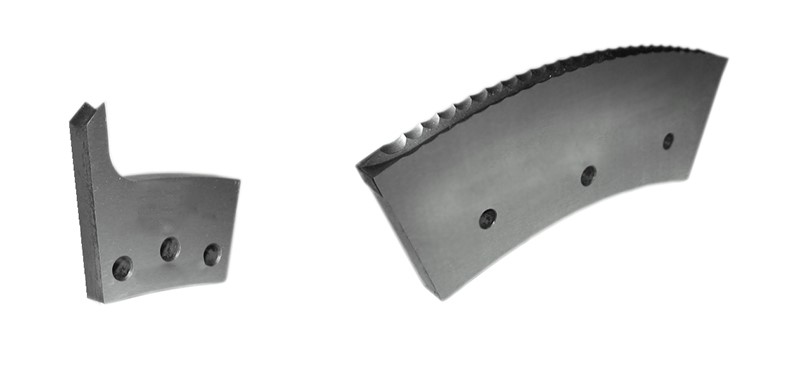In the paper industry, precision and efficiency in cutting processes are essential to ensure a high-quality final product. Industrial blades play a crucial role in this process, allowing materials to be cut with accuracy and at the required speed. The paper industry has some of the most diverse and specialized needs regarding cutting tools. Blades for paper come in various shapes and sizes to suit the specific application. However, not all blades are the same, and selecting the right type can make the difference between efficient cutting and inefficient production with higher maintenance costs.
In this article, we will explore the different types of blades used in the paper industry, their key characteristics, and the factors to consider when choosing the best option to maximize performance and reduce wear. From circular blades to straight blades, knowing which one is the most suitable for each application is crucial to improving productivity and maintaining the high standards the market demands.
Types of Industrial Blades for Paper Cutting: What’s the Best Option?

Cutting paper at an industrial level requires highly specialized blades, which vary depending on the type of material and production process. Below, we present the most common types of blades used in the paper industry:
- Longitudinal Cutting Blades: These blades are used for continuous cutting of paper rolls, dividing them into smaller coils or strips. They are essential in processes that handle large volumes of material, such as printing or packaging paper production. Their design ensures clean, precise cuts, minimizing waste and maintaining product uniformity.
- Crosscutting Blades: Also known as shears, these blades are designed to cut paper perpendicularly, creating individual sheets or predetermined sections. They are common in the manufacture of tissue paper and other products that require precision in the final cut size. Their ability to adapt to different paper thicknesses is key to production process flexibility.
- Circular Blades: These blades have a round shape and are used for both longitudinal and crosscutting at various stages of the production process. They offer great versatility, being suitable for high-speed cuts and ensuring uniform wear that prolongs their lifespan. They are particularly effective in producing fine paper products and packaging.
- Straight Blades: Straight blades are often used in processes where a precise and uniform linear cut is required. They are ideal for cutting large formats of paper or cardboard, where consistency is key. This type of blade is widely used in the manufacture of corrugated cardboard and other thick materials, where a robust and effective cut is needed.
Each of these blade types is designed to handle different stages of the cutting process in the paper industry, optimizing both precision and operational efficiency. Choosing the right blade depends on the type of material and the desired result in the final product.

Specialized Blades for Recycling Applications
- Recycling Blades: Specifically designed to withstand the demands of processing hard and abrasive materials like recycled plastics. These blades must maintain their sharpness for extended periods, even when facing high wear.
- Vulcanized Blades: These blades, reinforced with vulcanization processes, are ideal for applications that require additional resistance to dense materials or those with a high rubber content, ensuring precise and durable cuts.
Key Characteristics of Industrial Blades for Paper Cutting
When selecting blades for the paper industry, it’s essential to consider certain characteristics that will determine their performance and durability in cutting different materials, such as tissue paper or cardboard. These characteristics include:
- Material Composition: Blades should be made from high-strength steels to withstand constant wear under intensive use. Tungsten and carbon steel are common options.
- Surface Treatments: To increase durability and reduce friction during cutting, blades often undergo heat treatments and special coatings that extend their lifespan.
- Cutting Geometry: The design of the blade’s edge, whether beveled or straight, directly influences cutting precision and the blade’s ability to handle different thicknesses of paper, cardboard, and other materials.
- Wear Resistance: It’s essential that blades maintain their sharpness for extended periods. Abrasion resistance is a crucial quality, especially when cutting abrasive materials like cardboard or coated papers.
These characteristics not only affect cutting precision but also reduce downtime due to replacement or maintenance.
Maintenance of Blades for Paper Cutting
Proper maintenance of industrial blades is essential to ensure optimal performance and prolong their lifespan. Key aspects to consider include:
- Regular Sharpening: Periodically sharpening the blades helps maintain their precision and prevents irregular cuts or premature wear.
- Cleaning and Lubrication: Keeping the blades free of debris and properly lubricated reduces friction and the risk of damage.
- Wear Inspection: Regular inspections to identify wear or cracks can prevent major problems and reduce downtime.
- Timely Replacement: Knowing when to replace a worn blade is crucial to avoid production defects and ensure continuity in the process.
Cuchillas Castillo: Specialized Solutions for Paper Cutting
At Cuchillas Castillo, we are proud to offer tailored solutions for industrial paper cutting, developing blades that combine advanced technology and high-quality materials. Our expertise in blade manufacturing allows us to adapt our products to the specific requirements of each client, optimizing operational efficiency and ensuring precise and reliable results. 
Our personalized approach ensures that each project has the right tools to maximize blade productivity and durability.

